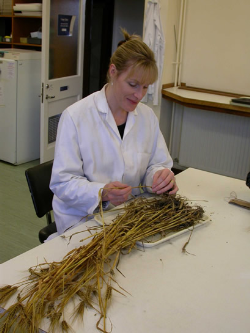
Wheat fungicide trials conducted by the SAC in 2005 demonstrated plenty of evidence to suggest that fungicide dose rates need to be kept up and that T-timings need to be accurate, especially with the high disease pressure this season.
According to Dr Fiona Burnett of the SAC, "the old story of keeping leaf three protected with a GS 32 T1 timing still stands. If you go on earlier, you risk leaving leaf three and leaf two unprotected until flag leaf when the eradication needed from a fungicide programme will be very high.
"I'd be looking at a robust T1 programme, for example 0.5 litres/ha of Opus at T1 and 0.75 litres/ha of Opus at T2 followed by a robust triazole + chlorothalonil on the head. This type of approach is essential on a disease susceptible variety like Consort; but there is also an argument for the same approach with a more resistant variety like Robigus where a decent T1 will give you more flexibility at the flag timing when it may be necessary to reduce fungicide spend."
That said Dr Burnett goes on to warn that "the addition of chlorothalonil at each timing will be critical and we are now also convinced of the need for its inclusion in the head spray. The head spray is increasingly important, especially on susceptible varieties. It is easy to forget that we are looking for additional Septoria tritici control from this T3 timing - it's not just about the ear disease control. Our 2005 trials really show the value of the robust triazole + chlorothalonil T3 spray for this added Septoria tritici control and yield, especially where the flag spray was weaker. Another point to note for Scottish Farmers is that from grower surveys we have conducted in Scotland, Fusarium culmorum is almost as important to control on the ear as Microdochium spp."
Based on 2005 results, Dr Burnett recommends that a low rate (0.25 litres/ha) of a strobilurin is still worth considering, with its inclusion having yielded 0.3 tonnes/ha in a number of SAC trials.
Andy Jones, Value Chain Manager for Cereals at BASF echoes Dr Burnett's views on dose rates. "It is false economy to apply rates that are too low, especially this season where the potential loss of yield from the whole gambit of foliar and stem-based disease is high," he says. "Dose reductions can easily deliver a saving in the short-term, but as presented at the HGCA roadshows in January, an increase in Opus dose rates from 0.3 litres/ha to 0.5 litres/ha plus chlorothalonil at T1, followed by 0.9 litres/ha of Opus at T2, showed an overall increase in margin of £8/ha.
"Tracker is proving to be a popular choice this season with growers spraying larger acreages because at a rate of 1 litre/ha it delivers a very good economical yield response plus it offers an ideal 'one pass' option at T1 acting as a Septoria tritici eradicant plus also delivering both stem-based disease control and rust control," he adds.
"As far as timings are concerned, growers need to ensure that the 3½ to four week window between T1 and T2 remains sacrosanct; it is important that T2 goes on at GS 39 and not before, if not, with the disease pressure we've seen already this spring, disease eradication will be a costly exercise," Mr Jones adds. "There is a strong case for adding a T2 strobilurin to counter the increased area of yellow-rust susceptible Robigus, and also for varieties with slips in brown rust ratings such as Claire and Istabraq. Pyraclostrobin (Comet 200) is particularly appropriate in these situations because independent assessments rated it as having the highest specific activity against brown rust of any fungicide tested."
